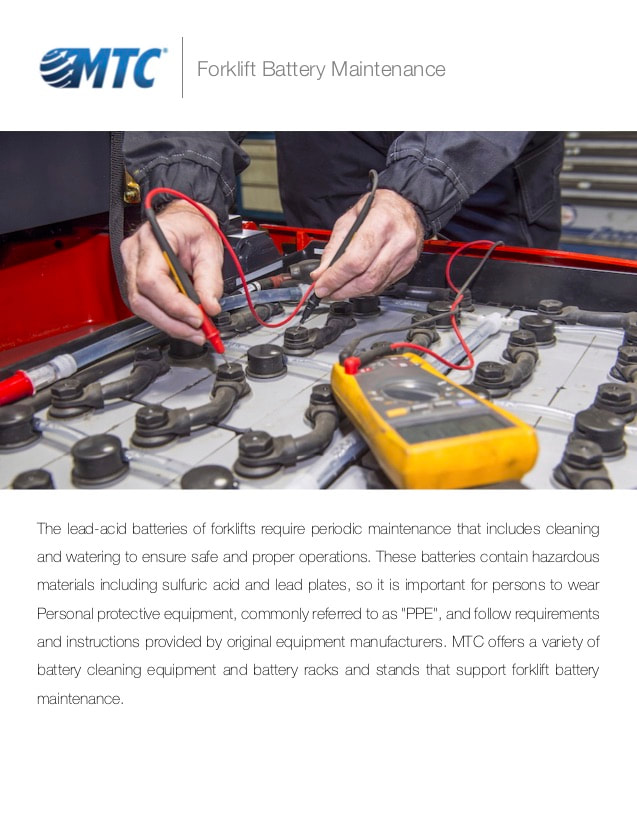
Forklift Battery Maintenance Guide
The MTC Forklift Battery Maintenance Guide is a single PDF document you can download. Which makes saving, printing, and sharing this maintenance information very convenient.
download as a pdf file
The MTC Forklift Battery Maintenance Guide is a single PDF document you can download. Which makes saving, printing, and sharing this maintenance information very convenient.
download as a pdf fileThe fluid in forklift lead-acid batteries is an electrolyte generally composed of very hazardous sulfuric acid and deionized water. This electrolyte reacts with the lead-based plates inside a battery to store and release energy in the form of direct current (DC) electricity. The level of electrolyte declines with battery usage so it must be periodically checked and maintained.
Adding deionized water to batteries is necessary. It replaces water that has evaporated due to battery heating, has been converted to oxygen and hydrogen by the electrolysis process that occurs during charging, or has boiled away during charging. The sulfuric acid portion of the electrolyte is intended to be permanent so adding more acid is rarely or never required. Lead-acid batteries that are losing an abnormal amount of water are not operating properly and should be inspected by a certified technician.
How to safely and correctly water batteries:
Failure to perform the basic maintenance of watering lead-acid batteries causes preventable problems including equipment safety risks, lower forklift productivity, and higher operational costs. Batteries with low electrolyte levels are prone to overheat, risking operator and facility safety. Poorly maintained batteries accept partial charges, allowing forklifts to operate for shorter periods each day. Chronically abnormal electrolyte levels minimize the number of charging cycles available before battery replacement is required.
Consult the Occupational Safety and Health Administration (OSHA)—and other applicable national, state, local, and industry organizations—for regulations, guidelines, and other information relevant to watering forklift batteries.
Cleaning and drying the lead-acid batteries of forklifts is vital because these batteries vent electrolyte, water vapor, and other gases during operation, charging, and filling. This creates a film of moisture on the batteries that accumulates airborne dust, oils, and other substances found in the environment. And since the heat from batteries evaporates the water portion of this film, what remains behind is very hazardous sulfuric acid and other impurities that make the film dangerously conductive to electricity. Dirty batteries can discharge through electrically conductive paths created between battery post connections and battery metal cases or forklift metal parts, which can result in the ignition of vented gases causing fires or explosions. For these reasons and others, it is necessary to keep forklift batteries clean and dry.
How to safely and correctly clean batteries:
Maintaining clean and dry lead-acid batteries makes forklift battery handling and charging safer by minimizing the opportunity for staff to come into contact with spilled water (avoids potential slips and falls), vented electrolyte (avoids potential chemical burns), and conductive battery surfaces (avoids potential electrical shorts). Cleaner batteries also prevent damage to battery terminals and cables, plus they prevent the unnecessary and expensive corrosion damage that would occur if battery fluids and residue were allowed to come into contact with forklift components and electronics.
MTC offers a number of battery cleaning solutions including battery wash racks, battery wash cabinets, and recirculating water systems designed to help maintain the cleanliness of forklift fleets and designed to reduce potential environmental problems associated with battery cleaning.
view mtc solutions